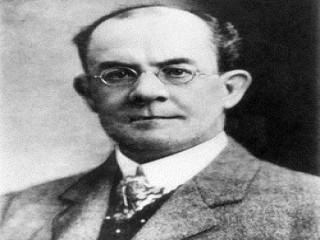
Herbert Akroyd-Stuart biography
Date of birth : 1864-01-28
Date of death : 1927-02-19
Birthplace : Halifax, Yorkshire, England
Nationality : English
Category : Arhitecture and Engineering
Last modified : 2011-05-31
Credited as : Mechanical engineer, hot bulb engine, original Akroyd oil engines
1 votes so far
He attended Newbury Grammar School, Berkshire, and the City and Guilds Technical College, Finsbury, where he assisted in the mechanical engineering department, and later worked in his father's Bletchley Iron and Tinplate Works which he managed after Charles's death.
Various experiments in engineering led Stuart to take out several patents. One day in 1885 he accidentally spilt oil from a paraffin lamp into a pot of molten tin. The oil vaporized, rose to the lamp and burst into flame. In his words, 'that lucky incident … gave me a clear insight … as to what happens when oil vapour is commingled with air and ignited. Straightaway, I began to think out a scheme … to design an engine to work on oil vapour'.
After further tests, in 1890 he and Charles Binney patented their 'Improvements in engines operated by the explosion of mixtures of combustible vapour or gas and air'. What followed was the Hornsby-Akroyd hot-bulb heavy-oil engine, constructed by Richard Hornsby & Sons who gained production rights next year. Their engine drew only air into the cylinder and compressed it, with the oil being injected at the end of the compression stroke. The first of its type, the engine proved a success: some operated for over sixty years. Manufactured under the Hornsby-Akroyd name, an oil engine for use in a military tractor earned Stuart a prize of £1180 from the British War Office in 1903. Strand magazine was to describe it in 1917 as 'the first definite proposal for a fighting machine on the lines of the existing tank'.
Having migrated to Western Australia in 1900, he joined his brother Charles who helped to form the engineering firm Saunders & Stuart; interested in gas producers, Herbert designed a highly successful unit operating on the downdraft system, using wood as fuel.
He maintained that he was the inventor of the compression ignition oil engine, ahead of Dr Rudolf Diesel whose German patents were taken out two years after Stuart's and who produced a successful engine some seven years after the Hornsby-Akroyd. Stuart's claim was supported by many, including his friend Professor William Robinson who tested several original Akroyd oil engines. To help establish his claim, Stuart made substantial bequests to the universities of Western Australia and Nottingham, and to the Institution of Mechanical Engineers, the Royal Aeronautical Society and the Institute of Marine Engineers, England. Income from the bequests is used for the Herbert Akroyd Stuart lectures on the origin and development of heavy oil engines. Modern oil engines use Stuart's method of oil-pump spray injection with constant volume burning in preference to the Diesel method of air-blast injection with constant pressure burning.
A courteous and gentle man who never married, Stuart was somewhat embittered by lack of recognition of his work. He died of throat cancer on 19 February 1927 at his home Akroydon, Claremont, Perth, and was buried in the cemetery of All Souls Anglican Church, Akroydon, Halifax, England. His will directed that his papers, drawings and models be burnt. In 1964 the local archaeological and historical society unveiled a stone tablet at Bletchley to mark the centenary of his birth.
















